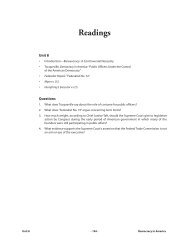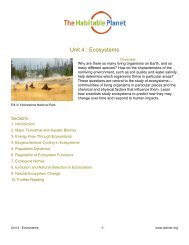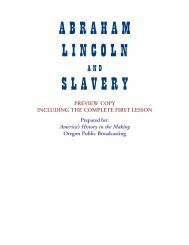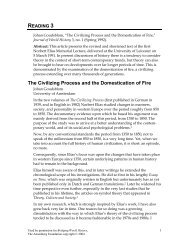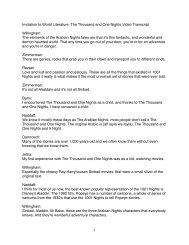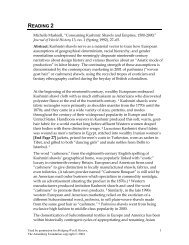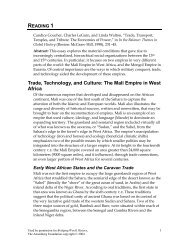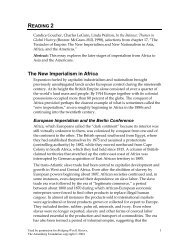UTOPIAN PROMISE - Annenberg Media
UTOPIAN PROMISE - Annenberg Media
UTOPIAN PROMISE - Annenberg Media
Create successful ePaper yourself
Turn your PDF publications into a flip-book with our unique Google optimized e-Paper software.
MORTON WEB ARCHIVE<br />
[1210] John Underhill, The Figure of<br />
the Indians’ Fort or Palizado in New<br />
England and the Manner of Destroying It<br />
by Captayne Underhill and Captayne<br />
Mason (1638), courtesy of the Library of<br />
Congress [LC-USZ62-32055]. In 1636,<br />
English settlers engaged in a genocidal<br />
campaign to wipe out the Pequot tribe.<br />
Captain John Underhill chronicled the<br />
Pequot War in his News from America<br />
(1638), providing this sketch of the<br />
Puritans, along with their Narragansett<br />
allies, encircling and destroying a<br />
Pequot village.<br />
[3217] The Bible and the Holy<br />
Scriptures Conteyned in the Olde and<br />
New Testament (1560), courtesy of the<br />
Library of Congress. Title page from the<br />
Geneva Bible depicting the pursuit of<br />
the Hebrews by the Egyptians, as<br />
described in Exodus. Puritans who envisioned<br />
themselves as New Israelites<br />
used this Bible.<br />
[6324] Sarony and Major, The Landing<br />
of the Pilgrims on Plymouth Rock,<br />
Dec. 11th 1620 (1846), courtesy of the<br />
Library of Congress [LC-USZC4-4311].<br />
Plymouth Rock has been used as a symbol<br />
of New England’s settlement as the<br />
first event in American history—a myth<br />
not supported by the complex history of<br />
Native Americans and European exploration<br />
and settlement.<br />
[6740] Nicolaes Visscher, Novi Belgii<br />
Novaeque Angliae: Nec Non Partis<br />
Virginae Tabula Multis in Locis Emendata<br />
(1685), courtesy of the Library of<br />
Congress [97683561]. This is a detail<br />
from the best-known map of New<br />
Netherland. The map details natural<br />
resources as well as geography. Beavers<br />
were a crucial, and profitable, trade<br />
item for places such Thomas Morton’s<br />
Mar-re-Mount.<br />
12 UNIT 3, <strong>UTOPIAN</strong> <strong>PROMISE</strong><br />
■ Compare Morton’s account of the maypole incident with<br />
Bradford’s. Ask students to generate a list of where the two stories<br />
agree on the facts and where they differ. What is at stake in these different<br />
accounts? Which is more persuasive? As your students draw<br />
their conclusions, ask them to consider the audiences Bradford and<br />
Morton were trying to reach.<br />
QUESTIONS<br />
Comprehension: What strategies does Morton use to satirize the<br />
Puritans in New English Canaan? How do the names he gives to the<br />
various characters in his tale undermine Puritan values and structures<br />
of authority? What is the significance of the title of his book?<br />
Context: How does Morton’s prose compare to Bradford’s “plain<br />
style”? Bradford draws most of his metaphors and allusions from<br />
the Bible; what sources does Morton draw upon? What kind of<br />
identity is Morton trying to construct for himself through his literary<br />
style?<br />
Exploration: Morton’s portrait of Native Americans is quite different<br />
from the accounts offered by most other seventeenth-century<br />
American writers. What qualities does he ascribe to the Indians?<br />
How does his description of Native American culture compare to<br />
his description of Puritan culture? What reasons might Morton<br />
have had to portray the Indians so positively? Why do you think<br />
Morton’s relationship to Native Americans was so threatening to<br />
the Puritans at Plymouth Plantation?<br />
Exploration: What genre do you think New English Canaan falls into?<br />
Is it a history, a satire, a travel narrative, a promotional brochure,<br />
or some combination thereof?<br />
Exploration: Read “The May-Pole of Merry Mount,” Nathaniel<br />
Hawthorne’s 1836 story about the conflict between Morton and the<br />
Puritans. How does Hawthorne portray the revelers? How does he<br />
portray the Puritans who confront them? With which group do his<br />
sympathies seem to lie? Why do you think Hawthorne chose this<br />
particular incident as the subject for his story?<br />
John Winthrop (1588–1649)<br />
Born into a wealthy landholding family in southern England in 1588,<br />
John Winthrop entered Trinity College, Cambridge, at the age of fourteen.<br />
At Trinity he considered studying to be a minister before ultimately<br />
deciding to become a lawyer. Although he did not choose to<br />
make the church his profession, Winthrop’s faith and his commitment<br />
to Puritan ideals were nonetheless the dominant force in his life.<br />
While he and his fellow congregants shared many values and beliefs<br />
with the Separatist Puritans who had settled at Plymouth, they did not<br />
accept the doctrine of Separation. Rather than breaking entirely with<br />
the established Church of England, Winthrop and his group sought to<br />
reform it from within.<br />
In 1629, uneasy about the English government’s hostility toward



